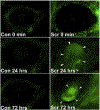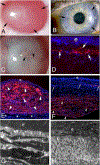Corneal wound healing
- PMID: 32553485
- PMCID: PMC7483425
- DOI: 10.1016/j.exer.2020.108089
Corneal wound healing
Abstract
The corneal wound healing response is typically initiated by injuries to the epithelium and/or endothelium that may also involve the stroma. However, it can also be triggered by immune or infectious processes that enter the stroma via the limbal blood vessels. For mild injuries or infections, such as epithelial abrasions or mild controlled microbial infections, limited keratocyte apoptosis occurs and the epithelium or endothelium regenerates, the epithelial basement membrane (EBM) and/or Descemet's basement membrane (DBM) is repaired, and keratocyte- or fibrocyte-derived myofibroblast precursors either undergo apoptosis or revert to the parent cell types. For more severe injuries with extensive damage to EBM and/or DBM, delayed regeneration of the basement membranes leads to ongoing penetration of the pro-fibrotic cytokines transforming growth factor (TGF) β1, TGFβ2 and platelet-derived growth factor (PDGF) that drive the development of mature alpha-smooth muscle actin (SMA)+ myofibroblasts that secrete large amounts of disordered extracellular matrix (ECM) components to produce scarring stromal fibrosis. Fibrosis is dynamic with ongoing mitosis and development of SMA + myofibroblasts and continued autocrine-or paracrine interleukin (IL)-1-mediated apoptosis of myofibroblasts and their precursors. Eventual repair of the EBM and/or DBM can lead to at least partial resolution of scarring fibrosis.
Keywords: Cornea; Corneal fibroblasts; Fibrocytes; Fibrosis; Infection; Injury; Interleukin-1; Keratocyte apoptosis; Myofibroblasts; PDGF; Scarring. corneal; Stromal-epithelial interactions; TGF beta; Wound healing.
Copyright © 2020 Elsevier Ltd. All rights reserved.
Conflict of interest statement
Proprietary interest statement
The author doesn’t have any commercial or proprietary interests in this study.
Figures




References
-
- Behrens DT, Villone D, Koch M, Brunner G, Sorokin L, Robenek H, Bruckner-Tuderman L, Bruckner P, Hansen U, 2012. The epidermal basement membrane is a composite of separate laminin- or collagen IV-containing networks connected by aggregated perlecan, but not by nidogens. J. Biol. Chem 287, 18700–18709. - PMC - PubMed
Publication types
MeSH terms
Grants and funding
LinkOut - more resources
Full Text Sources
Other Literature Sources
Medical

